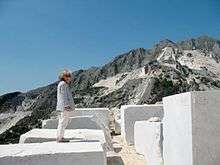Amalia Del Ponte

Amalia Del Ponte (Milan, 1936) is an Italian artist and designer.[1] She’s one of the most important independent artists of the Italian scene. She received appreciations from some important critics and art historians, such as Guido Ballo, Bruno Munari, Gillo Dorfles, Arturo Schwarz, Francesco Tedeschi, Flaminio Gualdoni and Tommaso Trini. Del Ponte’s researches are suspended between art and science through studies that investigates the relationship between sculpture, music, science and technology.[2] She started with a brilliant international debut in the '70s with the First Prize for Sculpture at the São Paulo Art Biennial.[3]
Early life and education
After art school, she attended from 1956 to 1961 the course of sculpture by Marino Marini[4] at the Accademia di Brera in Milan with Kengiro Azuma, Mario Robaudi and Gianni Colombo. Since the '60s she started her research on materials. This approach, almost scientific, pushed Del Ponte in a few years to create more simple and pure structures.
Career
In 1965 Amalia Del Ponte made her first sculptures in Plexiglas, bud from the analysis of basic geometric shapes. Two years later Vittorio Fagone named this works Tropi during a solo show ad Galleria Vismara in Milano.[5][6] In the '60s Del Ponte created the interior design of the fashion boutique Gulp! in Milano and those of the Elio Fiorucci’s first shop.[7]
The international reward arrived in 1973 when she was invited by Bruno Munari and Umbro Apollonio to participate at São Paulo Art Biennial (at that time one of the most important in the world) where Amalia Del Ponte won the First Prize for Sculpture with her work Area percettiva.[8] In 1993 Amalia Del Ponte exhibited some of his works called lithophones at the Fort Asperen in Netherlands. In 1995 Gillo Dorfles invited Del Ponte to participate at XLVI Venice Biennal with a personal room dedicated to her work inside the Italian Pavilion.[9] Here she exposed an original set-up of lithophones: sound stones that point out the invisible correspondences between geometric shapes, musical scales and colors.[10] In 2010 she created a project for the Certosa Island in the Lagoon of Venice; this was a series of video installations set up in the four Case Matte (Austrian powder kegs built by sea). The art work entitled Regno dei possibili, invisibili is about how art and science make visible otherwise invisible reality.[11][12][13][14]
References
- ↑ http://vimeo.com/21114925
- ↑ http://www.undo.net/it/magazines/1157715187
- ↑ documentario su Amalia Del Ponte (in Italian).
- ↑ http://farahzadart.com/080109.html
- ↑ (Italian) http://www.amaliadelponte.org/AmaliaDelPonte/tropi.html
- ↑ (Italian) http://archiviostorico.corriere.it/1994/gennaio/30/esperimenti_con_musica_co_0_9401306877.shtml
- ↑ http://vimeo.com/40928930
- ↑ http://issuu.com/bienal/docs/namee1bdf4
- ↑ (Italian) http://www.fondazioneitaliani.it/index.php?option=com_content&task=view&id=698&Itemid=43
- ↑ http://www.semarweb.com/biography.html#D
- ↑ (Italian) http://www.actv.it/regnodeipossibiliinvisibilimostradiamaliadelponteinaugurazione26giugnofinoal26settembre0
- ↑ (Italian) http://www.comune.venezia.it/flex/cm/pages/ServeBLOB.php/L/IT/IDPagina/37531
- ↑ http://www.agendavenezia.org/en/evento-18651.htm
- ↑ (Italian) http://www.connessomagazine.it/amalia-del-ponte-regno-dei-possibili-invisibili
Links
Official Web Site http://www.amaliadelponte.org/adp/en/